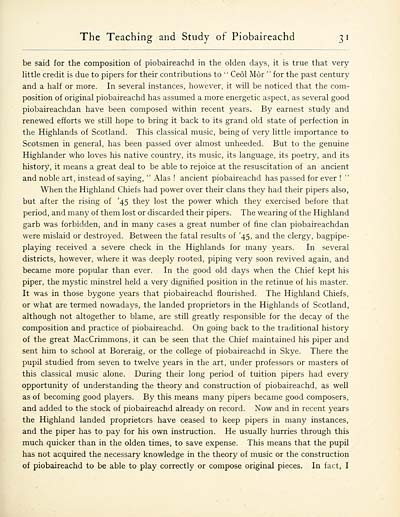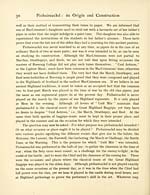Inglis Collection of printed music > Printed text > Piobaireachd [Tus is Alt a'Chiuil-Mhoir]
(37) Page 31
Download files
Complete book:
Individual page:
Thumbnail gallery: Grid view | List view

The Teaching and Study of Piobaireachd 3 1
be said for the composition of piobaireachd in the olden days, it is true that very
little credit is due to pipers for their contributions to " Ceol Mor "for the past century
and a half or more. In several instances, however, it will be noticed that the com-
position of original piobaireachd has assumed a more energetic aspect, as several good
piobaireachdan have been composed within recent years. By earnest study and
renewed efforts we still hope to bring it back to its grand old state of perfection in
the Highlands of Scotland. This classical music, being of very little importance to
Scotsmen in general, has been passed over almost unheeded. But to the genuine
Highlander who loves his native country, its music, its language, its poetry, and its
history, it means a great deal to be able to rejoice at the resuscitation of an ancient
and noble art, instead of saying, " Alas ! ancient piobaireachd has passed for ever !
When the Highland Chiefs had power over their clans they had their pipers also,
but after the rising of '45 they lost the power which they exercised before that
period, and many of them lost or discarded their pipers. The wearing of the Highland
garb was forbidden, and in many cases a great number of fine clan piobaireachdan
were mislaid or destroyed. Between the fatal results of '45, and the clergy, bagpipe-
playing received a severe check in the Highlands for many years. In several
districts, however, where it was deeply rooted, piping very soon revived again, and
became more popular than ever. In the good old days when the Chief kept his
piper, the mystic minstrel held a very dignified position in the retinue of his master.
It was in those bygone years that piobaireachd flourished. The Highland Chiefs,
or what are termed nowadays, the landed proprietors in the Highlands of Scotland,
although not altogether to blame, are still greatly responsible for the decay of the
composition and practice of piobaireachd. On going back to the traditional history
of the great MacCrimmons, it can be seen that the Chief maintained his piper and
sent him to school at Boreraig, or the college of piobaireachd in Skye. There the
pupil studied from seven to twelve years in the art, under professors or masters of
this classical music alone. During their long period of tuition pipers had every
opportunity of understanding the theory and construction of piobaireachd, as well
as of becoming good players. By this means many pipers became good composers,
and added to the stock of piobaireachd already on record. Now and in recent years
the Highland landed proprietcrs have ceased to keep pipers in many instances,
and the piper has to pay for his own instruction. He usually hurries through this
much quicker than in the olden times, to save expense. This means that the pupil
has not acquired the necessary knowledge in the theory of music or the construction
of piobaireachd to be able to play correctly or compose original pieces. In fact, I
be said for the composition of piobaireachd in the olden days, it is true that very
little credit is due to pipers for their contributions to " Ceol Mor "for the past century
and a half or more. In several instances, however, it will be noticed that the com-
position of original piobaireachd has assumed a more energetic aspect, as several good
piobaireachdan have been composed within recent years. By earnest study and
renewed efforts we still hope to bring it back to its grand old state of perfection in
the Highlands of Scotland. This classical music, being of very little importance to
Scotsmen in general, has been passed over almost unheeded. But to the genuine
Highlander who loves his native country, its music, its language, its poetry, and its
history, it means a great deal to be able to rejoice at the resuscitation of an ancient
and noble art, instead of saying, " Alas ! ancient piobaireachd has passed for ever !
When the Highland Chiefs had power over their clans they had their pipers also,
but after the rising of '45 they lost the power which they exercised before that
period, and many of them lost or discarded their pipers. The wearing of the Highland
garb was forbidden, and in many cases a great number of fine clan piobaireachdan
were mislaid or destroyed. Between the fatal results of '45, and the clergy, bagpipe-
playing received a severe check in the Highlands for many years. In several
districts, however, where it was deeply rooted, piping very soon revived again, and
became more popular than ever. In the good old days when the Chief kept his
piper, the mystic minstrel held a very dignified position in the retinue of his master.
It was in those bygone years that piobaireachd flourished. The Highland Chiefs,
or what are termed nowadays, the landed proprietors in the Highlands of Scotland,
although not altogether to blame, are still greatly responsible for the decay of the
composition and practice of piobaireachd. On going back to the traditional history
of the great MacCrimmons, it can be seen that the Chief maintained his piper and
sent him to school at Boreraig, or the college of piobaireachd in Skye. There the
pupil studied from seven to twelve years in the art, under professors or masters of
this classical music alone. During their long period of tuition pipers had every
opportunity of understanding the theory and construction of piobaireachd, as well
as of becoming good players. By this means many pipers became good composers,
and added to the stock of piobaireachd already on record. Now and in recent years
the Highland landed proprietcrs have ceased to keep pipers in many instances,
and the piper has to pay for his own instruction. He usually hurries through this
much quicker than in the olden times, to save expense. This means that the pupil
has not acquired the necessary knowledge in the theory of music or the construction
of piobaireachd to be able to play correctly or compose original pieces. In fact, I
Set display mode to: Large image | Transcription
Images and transcriptions on this page, including medium image downloads, may be used under the Creative Commons Attribution 4.0 International Licence unless otherwise stated. ![]()
| Special collections of printed music > Inglis Collection of printed music > Printed text > Piobaireachd [Tus is Alt a'Chiuil-Mhoir] > (37) Page 31 |
|---|
| Permanent URL | https://digital.nls.uk/94537952 |
|---|
| Description | Scottish and English songs, military music and keyboard music of the 18th and 19th centuries. These items are from the collection of Alexander Wood Inglis of Glencorse (1854 to 1929). Also includes a few manuscripts, some treatises and other books on the subject. |
|---|
| Description | The Glen Collection and the Inglis Collection represent mainly 18th and 19th century Scottish music, including Scottish songs. The collections of Berlioz and Verdi collected by bibliographer Cecil Hopkinson contain contemporary and later editions of the works of the two composers Berlioz and Verdi. |
|---|

